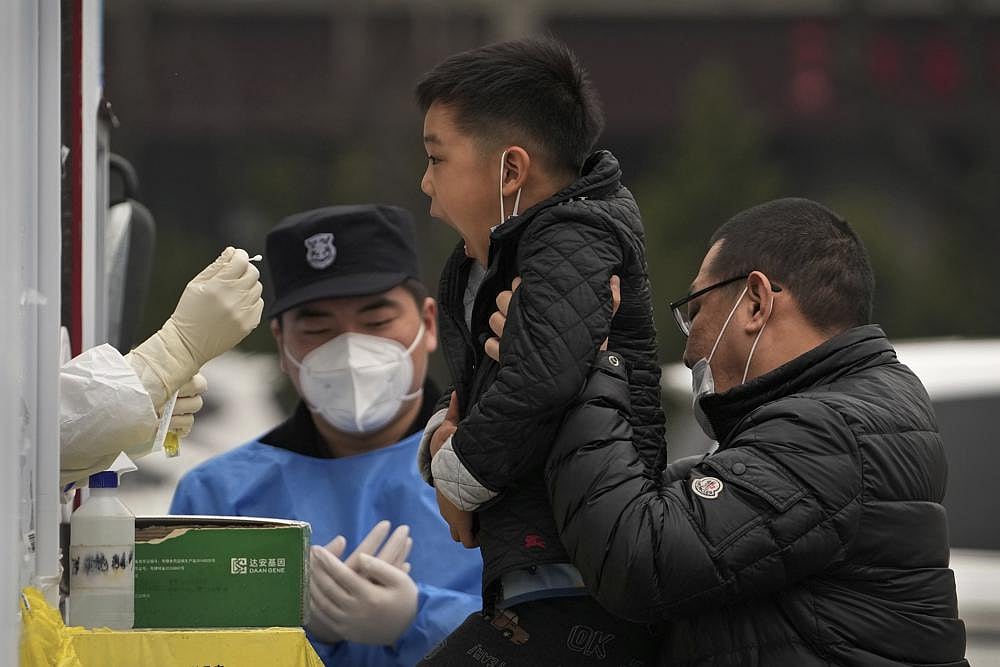China's 'zero COVID-19' strategy: Total lockdown in Shanghai bars residents from leaving home
While officials, including Communist Party leader Xi Jinping have encouraged more targeted measures, local officials tend to take a more extreme approach, concerned with being fired or otherwise punished over accusations of failing to prevent outbreaks

A man lifts his child to get a COVID-19 test at a private mobile coronavirus testing facility, on Tuesday, March 29, 2022, in Beijing | AP
A two-phase lockdown of Shanghai’s 26 million people is testing the limits of China’s hard-line “zero-COVID” strategy, which is shaking markets far beyond the country’s borders.
China’s largest city on Tuesday entered the second day of the lockdown’s first phase, which encompasses the Pudong financial district and adjacent areas on the east side of the Huangpu river that divides the center of finance, manufacturing and trade.
With public transport suspended and bridges and tunnels connecting the two sides of the city closed, usually bustling city streets — including the fabled riverside Bund in Puxi with its century-old historic buildings — were unusually quiet.
All residents in the Pudong district, home to many elite financial institutions and the Shanghai Stock Exchange, will be confined to their homes and allowed out only to get a Covid test, according to a statement issued by the area's residential compounds reviewed by Bloomberg News.
Residents shouldn't walk in the hallways, garages or open areas of their residential compounds in order to reduce the risk of infection, Wu Qianyu, an official with the Shanghai Municipal Health Commission, said during a briefing on Tuesday. That includes walking pets.
The new omicron BA.2 subvariant is widely blamed for bringing a new surge in cases to Shanghai, which had suffered relatively little effect from the pandemic that was first detected in the central Chinese city of Wuhan in late 2019.
The measures confining Pudong residents to their homes, closing nonessential businesses and requiring mass testing are due to be lifted Friday. At that time, the vast Puxi area on the opposite side of the Huangpu river that will go under lockdown.
Panic buying has struck markets and some residents have reported shortages of fresh meat and vegetables, including on online platforms. Authorities are working to ensure food supplies and have converted gymnasiums and exhibition centers to house patients, most of whom show no symptoms.
Government workers in hazmat suits, joined by some 68,000 volunteers, have fanned out to man checkpoints around residential compounds walled off with plastic traffic dividers and improvised barriers.
Shanghai recorded 4,477 new cases on Monday, all but 95 of them asymptomatic. Despite a nationwide surge, numbers of new COVID-19 deaths have remained low, with two more added on March 20 for a total of 4,638.
China has reported more than 56,000 confirmed cases nationwide this month, with the surge in Jilin accounting for most of them.
Although China’s vaccination rate is around 87%, it is considerably lower among older people who are more likely to become seriously ill if they contract the virus.
China has called its long-standing “zero-tolerance” approach the most economical and effective prevention strategy against COVID-19.
The new measures being enforced in Shanghai aim to “curb the virus spread, protect people’s life and health, and achieve the dynamic zero-COVID target as soon as possible,” the city’s COVID-19 prevention and control office stated in an announcement Sunday evening.
That requires lockdowns and mass testing, with close contacts often being quarantined at home or in a central government facility. The strategy focuses on eradicating community transmission of the virus as quickly as possible.
While officials, including Communist Party leader Xi Jinping have encouraged more targeted measures, local officials tend to take a more extreme approach, concerned with being fired or otherwise punished over accusations of failing to prevent outbreaks.
Most recently, Hunan province, which has seen relatively few cases, ordered punishments against 19 officials for “failure to vigorously consolidate anti-pandemic policies,” state broadcaster CCTV reported Monday.
With China’s economic growth already slowing, the extreme measures are seen as worsening difficulties hitting employment, consumption and even global supply chains. With a 21-day curfew in place for all foreigners arriving from abroad, travel between China and other countries has fallen dramatically.
The intensified restrictions underscore the challenge Chinese officials face in implementing President Xi Jinping's call for containment measures to be both effective in stifling Covid and minimal in their social and economic impact.
While the southern Chinese tech hub Shenzhen saw infections wind down to single digits after it emerged from a week-long lockdown, cities including Langfang and Tangshan near capital Beijing, as well as the entire northeastern province of Jilin, have remained sealed off for up to two weeks.
(with inputs from AP)
RECENT STORIES
-
-
-
-
-